The iPhone 7 and iPhone 7 Plus Review: Iterating on a Flagship
by Joshua Ho & Brandon Chester on October 10, 2016 8:00 AM EST- Posted in
- Smartphones
- Apple
- Mobile
- iOS
- iOS 10
- iPhone 7
- iPhone 7 Plus
GPU Performance
Section by Brandon Chester
Now that the general system and CPU performance of A10 Fusion has been characterized, we can move on to more focused benchmarks for the GPU and the storage subsystem. Apple's keynote for the iPhone 7 actually disclosed that the GPU in A10 Fusion is a six core part. The last time I recall Apple mentioning specifics about their GPU was with the launch of the iPad 3, where the GPU was advertised as a quad core implementation that turned out to be SGX543MP4.
The use of a six core GPU is interesting because there's not much choice for Apple given that A9 also used the six core PowerVR GT7600. It really boils down to three possibilities. The first is that Apple has actually continued using the exact same GT7600 microarchitecture as on the A9, albeit with an improved layout on the die. The second is that Apple has moved to PowerVR GT7600 Plus, which brings some improvements to integer compute performance, and memory bandwidth optimizations. And the third is the wildcard option - that Apple has put to use its significant GPU engineering resources on a more customized design; something that's still using the PowerVR architecture, but more custom than ever before. This is a longer discussion to have in our full deep dive, but Ryan's of the opinion that this is somewhere between options two and three, that Apple has done some significant work to produce a highly optimized version of the PowerVR GT7600 Plus
In any case, as Apple isn't using a radically different GPU architecture, most of Apple's stated 50% increase in GPU power comes from increasing the clock speeds, with optimizations such as memory and caching picking up the rest. This is interesting because Apple also advertises that A10 Fusion's GPU uses only two thirds the power of A9, which would indicate a lot of work done by Apple to optimize for power usage.


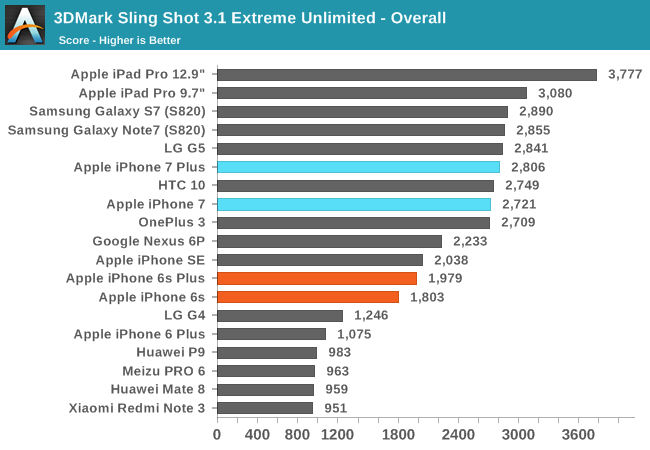
3DMark Sling Shot is broken down into a few different tests, and at the end the results of graphics tests and physics tests produce separate scores which are then used to generate an overall score.
In the graphics test the results are in line with Apple's stated GPU performance improvement of 50%. The physics score, which is really a CPU test, only improves by 30-35%, which has a direct correlation to the increase in peak clock speed from 1.8GHz on A9 to 2.3GHz in A10 fusion.
Like Ice Storm, the physics test is still basically a chart of devices ranked by cores multiplied by max frequency, and you can see that the iPhones have improved very little over the years, with the improvements tracking closely to Apple's increases in CPU clock speed. This comes down to the test being designed in such a way that there's little instruction level parallelism to exploit due to memory dependencies, which puts Apple's wide dual core CPU at a disadvantage. While it is certainly a valid test situation, it's not really reflective of actual 3D game performance because you would generally not write a game in such a way that it cannot exploit the performance of its target hardware.
Even with the smaller improvement in the physics tests, the overall score for the iPhone 7 is still roughly 50% higher than the Apple A9 devices like the iPhone 6s and SE.
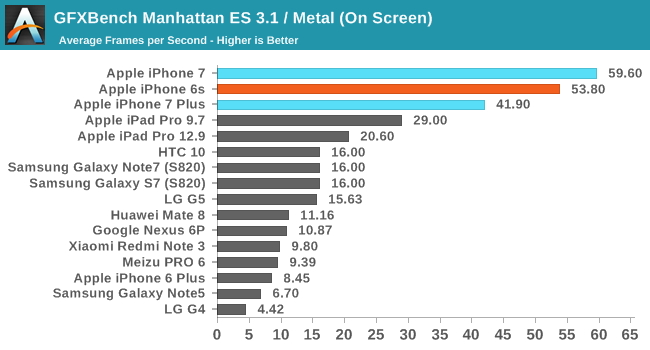
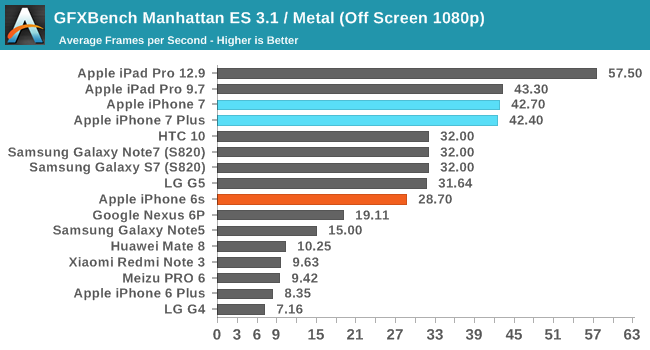
We originally migrated away from Manhattan ES 3.0 to Manhattan ES 3.1 / Metal to push back on devices hitting VSync in the on screen tests. Unfortunately it didn't work for long. With the iPhone 7's increase in GPU performance not being accompanied by an increase in display resolution, the on screen result in GFXBench Manhattan is higher than any other device, and is essentially at the display's refresh limit. The iPhone 7 Plus isn't able to hit Vsync due to its higher resolution, but the on screen result of roughly 42fps is nothing to scoff at either considering the visual complexity of the test.
While on screen performance is helpful from the perspective of someone who wants to see how the phone will actually perform when running a game at its native resolution, to compare directly between devices you need to standardize the rendering resolution. As its name implies, GFXBench's off screen test simply renders all the frames at 1080p in an off screen buffer. In this test the iPhone 7 and 7 Plus both run slightly below 43fps, which puts them right where you'd expect from Apple's claim of 50% greater GPU performance. In GFXBench this also puts the two of them at the same level as the 9.7" iPad Pro for absolute GPU performance.
This gives some interesting insight into the relative clock speeds that Apple is running their GPUs at, as A9X uses a twelve core PowerVR Series7XT GPU, while A10 Fusion uses only six. As I mentioned before, the performance improvements in A10 Fusion primarily come from increasing the peak clock speed. Matching the 9.7" iPad Pro's A9X suggests that Apple has targeted a fairly aggressive clock speed for the GPU in A10 Fusion, and while we can't verify Apple's claim of A10's GPU running at only two thirds the power of A9, if that is indeed the case it would represent a great deal of optimization effort on Apple's part to achieve that despite increasing clock speeds this significantly.
Storage Performance
One of the big changes that came with Apple's A9 and A9X SoCs was a new storage controller designed internally at Apple. This was not the first Apple product to use an in-house SSD controller, as the 2015 MacBook used a PCIe SSD and adopted the NVMe interface. A9 and A9X adapted this for use in mobile, and the sequentual performance in particular was far ahead of anything in a competing mobile device.
Apple hasn't advertised any improvements to storage performance with A10 Fusion, but it's worth running tests to verify that performance has remained at the same level. There are also potential gains in write performance when increasing the total capacity of an SSD by adding additional dies. At this point there's really no benchmark that can give comperable results between iOS and Android, so I've decided against doing a cross-platform comparison here.
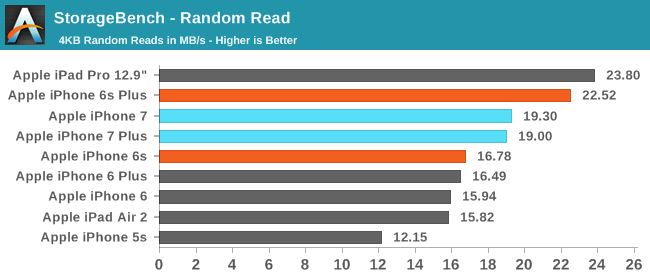
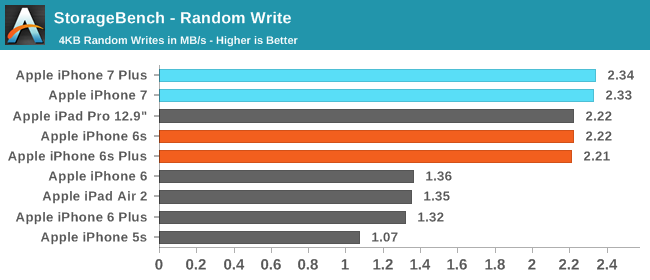

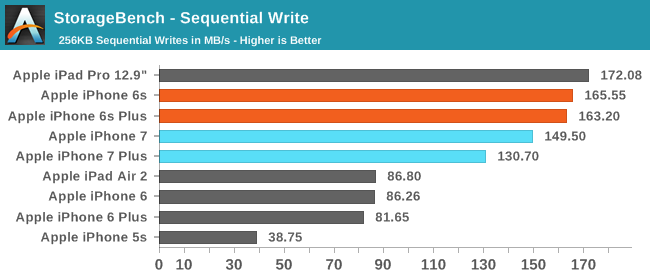
In general, the NAND performance of the iPhone 7 and 7 Plus is equivalent to the iPhone 6s and 6s Plus. There are some minor differences, but essentially all of them can be attributed to testing variance. The only thing that is worth noting is that there's no significant improvement to write performance even though the iPhone 7 units tested are 256GB models while the 6s and 6s Plus were 128GB models. This suggests that the NAND packages use higher capacity dies so there's no additional parallelism to take advantage of.










377 Comments
View All Comments
grayson_carr - Monday, October 10, 2016 - link
You can still use your old headphones with the adapter included in the box.The Pixel has a better camera? I didn't realize reviews were already out.
Mediocre battery life? Did you even read the review? the only noteworthy phone that beats the iPhone 7 is the S7 Edge, and it beats it by what, 20 minutes?
The iPhones will charge a lot faster if you buy an iPad charger. Sucks that they don't include a higher W charger in the box, but you at least have an option for faster charging.
Good to know the screen with the most accurate colors of any phone ever, and the only one to include proper color management, and one of brightest screens of all time is passable!
So it's not worth $650-750 for you. Ok. That's fine. It seems to be worth that much to a whole bunch of other people though.
SquarePeg - Monday, October 10, 2016 - link
https://www.dxomark.com/Mobiles/Pixel-smartphone-c...grayson_carr - Tuesday, October 11, 2016 - link
Well if they said it, it must be true. After some of the scores they have given certain Sony phones, I will never trust them.jlabelle2 - Thursday, October 13, 2016 - link
"After some of the scores they have given certain Sony phones, I will never trust them."Here we are again... And earth is flat, I know...
mef - Monday, October 10, 2016 - link
"The screen is just passable": really???http://www.displaymate.com/iPhone7_ShootOut_1.htm
The iPhone 7 matches or breaks new Smartphone display performance records for:
• The Highest Absolute Color Accuracy for any display (1.1 JNCD) – Visually Indistinguishable from Perfect
• The Highest Absolute Luminance Accuracy for any display (±2%) – Visually Indistinguishable from Perfect
• Very Accurate Image Contrast and Intensity Scale (with Gamma 2.21) – Visually Indistinguishable from Perfect
• The Highest Peak Brightness Smartphone for any Average Picture Level APL (602 to 705 nits)
• The Highest (True) Contrast Ratio for any IPS LCD display (1,762) – Higher Dynamic Contrast Ratios are phony
• The Lowest Screen Reflectance for any Smartphone display (4.4 percent)
• The Highest Contrast Rating in High Ambient Light for a Smartphone for any APL (137 to 160)
• The Smallest Color variation with Viewing Angle (2.1 JNCD or less)
Toss3 - Tuesday, October 11, 2016 - link
They compared it to the iPhone 6, and while it is accurate, many people would still pick an AMOLED screen over the LCD any day of the week; samsung's recent amoled-screens are almost as accurate (negligible difference really, with infinite contrast and higher perceived sharpness both due to an increase in contrast and pixel density).R. Hunt - Thursday, October 13, 2016 - link
OLED will only be accepted by mainstream media as vastly superior the moment Apple starts using it.We all know this.
techconc - Thursday, October 13, 2016 - link
No, DisplayMate's review was not simply comparing the screen to the iPhone 6. There are areas where the iPhone 7 screen is best in class overall. Moreover, in a recent Wired article Dr. Soneira went on to say that the best screen overall is a "toss up" between the Galaxy's OLED and the iPhone 7's LCD. Both have inherent strengths and weaknesses. Neither is better overall.https://www.wired.com/2016/09/iphone-7s-screen-loo...
Constructor - Monday, October 17, 2016 - link
No, they're not, since Android has no color management whatsoever. Plus AMOLED deteriorates over time, including pixel-wise burn-in and incremental color degradation (also varying across the display area).Samsung et al clearly don't care much about as you can see from their short support span for these devices, but Apple devices are often used for many years and they stay very high quality for years; They also get full update and upgrade support directly from Apple for 5 years.
AMOLED is simply not good enough and not durable enough for that, even if you did calibrate it in the factory and if you had an OS with color management.
TechnologyGuy - Monday, October 10, 2016 - link
I specifically made no mention of the OS because that is subjective. I have owned both Android and iOS phones and I have always preferred Android over iOS. I do understand people might prefer one over the other but I like to micro-manage and customization of every little detail is important to me.Yes, Pixel camera reviews are out - please search for yourself. Plugging in an adapter/dongle is not what I want to bother to do every time I use the phone. An extra accessory to lose, a feature that adds zero (negative) value for me. Battery life in real world usage is not quite the same as on the test - two of my colleagues have already acquired the phone with poorer battery life than the 6S. In addition, other sites' battery tests do show mediocre results for the iPhone 7.
I am aware of the color accuracy, which is why I said passable. Simply put, a so-so black level and a resolution below quad HD is not acceptable for my use. And yes, I can tell the difference on a 5 inch phone.